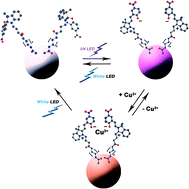Spiropyran derivatives have been immobilised on the surface of polystyrene microbeads using different immobilisation strategies. These functionalised polymeric beads can be reversibly switched between the colourless inactive spiropyran (SP) and highly coloured (purple) active merocyanine (MC) forms using low power light sources, such as light-emitting diodes (LEDs). A UV LED (375 nm) is used for the SP → MC conversion, and a white LED (430–760 nm) for the reverse MC → SP conversion. The photochromic behaviour of the coated beads has been characterised using different LEDs and reflection spectroscopy, employing optic fibres and an in-house-designed holder. Investigations into the metal-ion binding behaviour of the spiropyran-modified microbeads have shown that Cu2+ ions cause an appreciable colour and spectral change when brought into contact with the beads in the MC form, suggesting that a significant interaction is occurring. However, the Cu2+ ions can be completely expelled by photonic-conversion of the beads into the inactive SP form using a white LED. This sequence has been successfully repeated six times, suggesting that it is possible to cycle through activation of the functionalised beads from a non-binding to a binding form (SP → MC) using a UV LED, allow binding with Cu2+ ions to occur, and subsequently, expel the bound ions and regenerate the passive SP surface using a white LED. Other metals, such as calcium, do not cause any appreciable colour or spectral change over the same concentration range and in the presence of the same anion (final concentration 7.1 × 10−4 M nitrate salt in ethanol). The system is therefore self-indicating in terms of whether the active MC or inactive SP forms are present, and whether Cu2+ ions are bound to the MC form. In principle, therefore, these functionalised beads could form the basis of a photoswitchable stationary phase for metal ion binding and detection: irradiation of the stationary phase with UV LEDs causes retention of guest species due to the presence of the MC form, while subsequent exposure to white LEDs causes release of guest species into the mobile phase.

You have access to this article
 Please wait while we load your content...
Something went wrong. Try again?
Please wait while we load your content...
Something went wrong. Try again?


 Please wait while we load your content...
Please wait while we load your content...